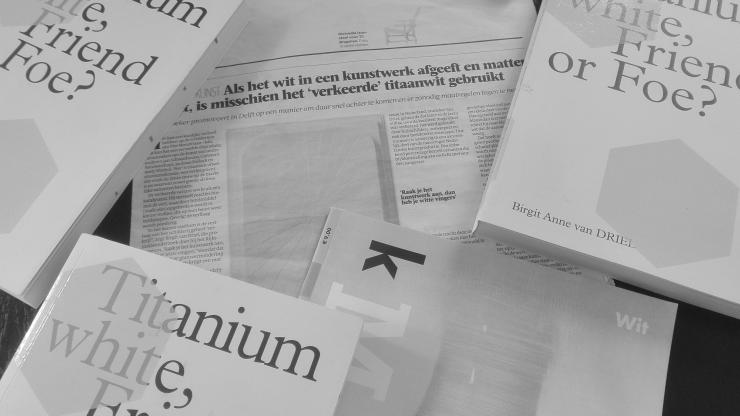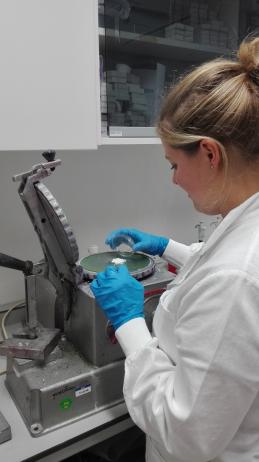A dissertation written by Dr.Ir. Birgit Anne van Driel in a collaborative project between the Rijksmuseum, the Cultural Heritage Agency of the Netherlands, Delft University of Technology with finanancial and analytical support from AkzoNobel (2014-2018).
Introduction
Titanium dioxide is the white of the 20th century. The development of suitable TiO2 pigments has led to a wide variety of pigments all called “titanium white”. The crystal structure can be rutile or anatase, the production process can be the sulfate or chloride process, the pigments can be composite or pure pigments, the size and surface areas of the pigments vary as well as the surface treatments which may consist of different layers of metal oxides and organic surface treatments. All these variations result in ‘good’ or ‘bad’ TiO2 pigments.
TiO2 easily absorbs UV-photons causing electrons to be exited from the valence band to the conduction band. In ‘bad’ pigments, the electron and hole can separate and migrate to the surface where redox reactions with adsorbed water and oxygen from the atmosphere causes the production of highly reactive radicals. These radicals may then participate in any radical-based reaction with its organic surrounding (binder/additives/pigments e.g.) causing degradation (such as chalking). In ‘good’ pigment the electron and the hole recombine after UV-absorption and the titanium dioxide functions as a UV-absorber protecting the organic environment from photo-oxidative degradation.
In short: art objects containing titanium dioxide white pigments in organic surroundings may degrade faster or slower than their unpigmented counterparts depending on the type of pigment.
A challenge…
The process of TiO2 photocatalysis has been widely researched for a range of applications (such as self-cleaning coatings). Based on this knowledge, we had expected problems with TiO2-based oil paints to be omnipresent in modern art collections. However, this turned out not to be the case, which resulted in the use of a novel ‘not case-study based’ approach to my project. This approach, distinctly different from most research in the conservation science field, incorporates aspects from fundamental science as well as keeping a very applied character.
Approach
The basis was to form and test hypotheses on why the expected degradation was not present yet and to develop prediction approaches to define which object may be susceptible to degradation in the future. Prediction tools resulted in practical guidelines for risk assessment and management of modern art collections containing works of art with TiO2 pigments.
Research
My extensive resulted in a dissertation with three distinct parts: 1) characterization of the use and properties of titanium white pigments, 2) understanding and monitoring the degradation of titanium white containing oil paints and 3) predicting degradation caused by titanium white pigments. In my dissertation hypotheses such as ‘the photocatalytic degradation process in oil paintings is slow’ are tested; tools such as ‘a photocatalytic activity test for TiO2 pigments in a paint fragment’ are developed and analytical techniques such as ‘atomic force microscopy coupled with infrared spectroscopy’ are evaluated for the use in conservation science. The true added value of this PhD research lies in the synthesis of all three parts providing an up-to-date and accurate overview of TiO2-pigments, their use and the degradation process they catalyse as well as a risk assessment and management strategy based on simple photocatalytic activity testing.
Are you interested in learning more? The PhD dissertation and scientific publications are available online.
PhD thesis available online at:
https://repository.tudelft.nl/islandora/object/uuid%3Aa64b7f31-a45b-4868-8978-70256e2ecb4f
All published articles available at:
- https://www.sciencedirect.com/science/article/pii/S0026265X15003288
- https://www.sciencedirect.com/science/article/pii/S1386142516302013
https://pubs.acs.org/doi/abs/10.1021/acsami.7b00638 - https://link.springer.com/article/10.1186/s40494-018-0185-2
- https://link.springer.com/article/10.1186/s40494-018-0183-4
- https://www.tandfonline.com/doi/abs/10.1080/00393630.2018.1503863
- https://www.sciencedirect.com/science/article/pii/S0143720817325469
Other appearances:
- https://www.iiconservation.org/node/7797
- https://www.c2w.nl/nieuws/afm-boogie-woogie/item18907
- https://www.volkskrant.nl/cultuur-media/podcast-birgit-van-driel-over-haar-baanbrekende-onderzoek-naar-titaanwit-in-kunst~b78902c7/
- https://www.volkskrant.nl/cultuur-media/schadelijk-titaanwit-in-nederlandse-kunst-dat-kan-vanaf-nu-snel-worden-getest~b896caa2/
- http://www.nicas-research.nl/individual-projects/titanium-white.html
- https://www.tudelft.nl/2017/3me/veroudering-van-schilderijen-picasso-en-mondriaan-beter-te-monitoren-en-te-voorkomen/
- https://lookingthroughartblog.wordpress.com/2016/11/25/titanium-white-a-villain-to-other-pigments/
- https://www.kunstenaarsmateriaal.nl/index/km-106-wit
Bio
Dr. Ir. Birgit Anne van Driel has a background in Chemical Engineering (B.Sc.) and Materials, Science and Engineering (M.Sc.) from Delft University of Technology (TUD) and the Ecole Fédérale polytechnique de Lausanne (EPFL) respectively. Additionally she conducted a minor in Art Science and Archaeology at the Free University in Brussels (2009) and she performed MA-XRF analysis at the Museum of Modern Art in New York (2013). Between 2014 and 2018 she was employed at the Rijksmuseum working on her PhD project: “Titanium White, Friend or Foe?”. She defended her PhD on May 9th 2018 and was awarded her PhD degree cum laude.


